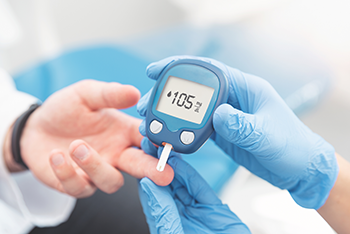What is Diabetes? Learn More During Diabetes Awareness Month
- Category: Endocrine & Diabetes Care, Health Tips
- Posted On:
There are four types of diabetes: Type 1, Type 1.5 or Latent autoimmune diabetes in adults (LADA), Type 2 diabetes, and Gestational diabetes.
Millions of Americans live with diabetes and prediabetes, which can affect your life and lead to serious health complications. Diabetes is a disease that occurs when your blood glucose, also called blood sugar, is too high. Blood glucose is the main source of energy and our bodies get it from the food we eat or can be over-produced by the liver. Insulin, a hormone made by the pancreas, helps glucose from the food we eat get into our cells so the body can use it for energy. If the body doesn’t make enough insulin or doesn’t use insulin well, the glucose will stay in your blood and not reach the cells. Over time, you may develop prediabetes and/or diabetes.
“High blood sugar or uncontrolled diabetes over time can cause nerve damage, lead to kidney damage or failure, impair vision or lead to blindness, and increase your risk of a heart attack or stroke along with other problems that may cause long-term disability,” says Dr. Loquintha Rex Vital, CMHS’s Inpatient Diabetes Specialist Nurse Practitioner.
Types of Diabetes
There are four types of diabetes: Type 1, Type 1.5 or Latent autoimmune diabetes in adults (LADA), Type 2 diabetes, and Gestational diabetes.
- Type 1 diabetes is when the body does not make insulin. Your immune system attacks and destroys the cells in your pancreas that make insulin. People with Type 1 diabetes need to take insulin daily to survive. People with Type 1 diabetes are more commonly diagnosed when they are young but can be diagnosed later in life as well. About 1 in 10 people with diabetes have Type 1 diabetes.
- LADA is similar to Type 1 diabetes except most patients who develop LADA are diagnosed after age 30. LADA patients often come in with symptoms like patients with Type 2 diabetes, but commonly require insulin to control their blood glucose much faster. LADA patients are often at a healthy weight.
- Type 2 diabetes is the most common type of diabetes and occurs when your body does not use insulin right. This most often occurs in middle-aged and older people but it is occurring in people at a younger age every year. We are even starting to seen young kids with Type 2 diabetes. Nine out of 10 people with diabetes typically have Type 2 diabetes.
- Gestational diabetes develops in some pregnant women. Commonly, gestational diabetes goes away after the baby is born. However, a woman who had gestational diabetes has a greater chance of developing Type 2 diabetes later in life.
 There are four blood tests that can be done to see if you have an elevated blood sugar. These tests include a random plasma glucose, fasting blood glucose, an oral glucose tolerance test, and hemoglobin A1C.
There are four blood tests that can be done to see if you have an elevated blood sugar. These tests include a random plasma glucose, fasting blood glucose, an oral glucose tolerance test, and hemoglobin A1C.
Prediabetes: The American Diabetes Association says over 84 million American adults have prediabetes but most people don’t even realize it! Prediabetes is a condition where the person’s blood glucose is higher than normal, but the blood glucose is not high enough to diagnose the person with diabetes. Prediabetes is not a condition to ignore. It is estimated that 15 to 30 percent of people with prediabetes will develop Type 2 diabetes in less than five years if they do not make lifestyle changes. Persons with prediabetes often do not have any symptoms. Having prediabetes or diabetes places you at a greater risk of developing cardiovascular disease.
Testing: There are four blood tests that can be done to see if you have an elevated blood sugar. These tests include a random plasma glucose, fasting blood glucose, an oral glucose tolerance test, and hemoglobin A1C. The random plasma glucose measures your blood glucose at that time. The fasting blood glucose measures your blood glucose when you have not eaten for at least eight hours or first thing in the morning. The oral glucose tolerance test checks blood glucose two hours after you have consumed a 75 gm glucose drink. The hemoglobin A1C is a blood test that measures the percent of sugar that attaches to your red blood cells over a two- to three-month period. The higher your A1C result, the longer your blood glucose has been elevated. If you are tested and have an abnormal result, your doctor may retest you using one of the other tests to confirm your diagnosis. Ask your doctor which test is right for you.
Click here to see chart.
Five Facts About Diabetes & Prediabetes
- 3 million Americans, or 9.4 percent of the population, has diabetes.
- The percentage of adults with diabetes increases with age, reaching a high of 25.2 percent among those 65 and older.
- 5 million Americans are diagnosed with diabetes every year.
- 1 million Americans age 18 and older have prediabetes.
- Diabetes was the seventh leading cause of death in the United States in 2015. It can also lead to significant disability over time if not controlled.
*Source: CDC’s National Diabetes Statistics Report, 2017
Diabetes Risk Factors
- Being 45 or older
- If you are Black, Hispanic/Latino, American Indian, Asian American, or Pacific Islander
- If you have a parent, brother or sister with diabetes
- If you are overweight and/or physically inactive
- If you have high blood pressure or take medicine for high blood pressure
- If you have low HDL cholesterol and/or high triglycerides
- If you had diabetes during pregnancy
- If you have been diagnosed with Polycystic Ovary Syndrome
